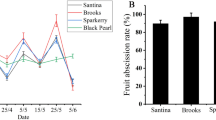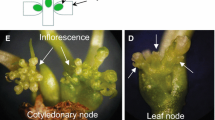Abstract
The frequent occurrence of polycarpy is the most serious problem directly compromising sweet cherry productivity in warm regions of the world. MADS-box genes play an important role in regulating the pistil development; however, limited evidence is available for understanding the regulatory mechanisms of MADS-box genes underlying multi-pistil formation in sweet cherry. In our study, we found that the multi-pistil occurred more frequently in the warm region of Shanghai than the cool region of Dalian. Particularly, the multi-pistil rate of ‘Tieton’ reaches 80–90%, which is much higher than that of ‘Lapins’ with 20–30% in Shanghai. PaAG, PaTM6, and PaMADS3/4/5/12 were found to be sensitive to different natural temperatures related to the formation of multiple pistils according to the quantitative real-time PCR assay. Moreover, the heat shock element in the promoter of PaMADS12 was identified. Using the GUS histochemical assay, we found that the expression level of the β-glucuronidase in the transgenic N. benthamiana leaves containing the GUS reporter gene driven by the PaMADS12 promoter was much higher at 35 °C than that at 25 °C. This suggested that PaMADS12 is a heat-induced transcription factor functioning in multi-pistil formation. Together, these results indicated that heat induced the expression of PaMADS12, and PaAG, PaTM6, and PaMADS3/4/5/12 were important components of the regulatory network controlling multi-pistil formation in sweet cherry.





Similar content being viewed by others
References
Beppu K, Kataoka I (1999) High temperature rather than drought stress is responsible for the occurrence of double pistils in ‘Satohnishiki’ sweet cherry. Sci Hortic 81:125–134
Beppu K, Kataoka I (2000) Artificial shading reduces the occurrence of double pistils in ‘Satohnishiki’ sweet cherry. Sci Hortic 83:241–247
Beppu K, Kataoka I (2011) Studies on pistil doubling and fruit set of sweet cherry in warm climate. J Jpn Soc Hortic Sci 80:1–13
Beppu K, Sumida H, Kataoka I (2015) Cloning and characterization of APETALA3-like and PISTILLATA-like B class MADS-box genes from sweet cherry. J Appl Hortic 17:87–91
Beppu K, Sumida H, Kataoka I (2017) Sweet cherry MADS-box genes ‘PaAG’ and ‘PaSHP’ homologous to class C floral identity genes. Acta Hortic 1161:49–54
Bowman JL, Smyth DR, Meyerowitz EM (1991) Genetic interactions among floral homeotic genes of Arabidopsis. Development 112:1–20
Ditta G, Pinyopich A, Robles P, Pelaz S, Yanofsky MF (2004) The SEP4 gene of Arabidopsis thaliana functions in floral organ and meristem identity. Curr Biol 14:1935–1940
Galimba KD, Tolkin TR, Sullivan AM, Melzer R, Theißen G, Di Stilio VS (2012) Loss of deeply conserved C-class floral homeotic gene function and C- and E-class protein interaction in a double-flowered ranunculid mutant. Proc Natl Acad Sci 109:13478–13479
Honma T, Goto K (2001) Complexes of MADS-box proteins are sufficient to convert leaves into floral organs. Nature 409:525–529
Hsu CC, Wu PS, Chen TC et al (2014) Histone acetylation accompanied with promoter sequences displaying differential expression profiles of B-class MADS-box genes for Phalaenopsis floral morphogenesis. PLoS ONE 9:e106033
Imrak B, Sarier A, Kuden A, Kuden AB, Comlekcioglu S, Tutuncu M, Turkey A (2014) Studies on shading system in sweet cherries (Prunus Avium L.) to prevent double fruit formation under subtropical climatic conditions. Acta Hortic 10:111–116
Kenneth JL, Thomas DS (2001) Analysis of relative gene expression data using real-time quantitative PCR and the 2–∆∆CT method. Methods 25:402–408
Kobayashi K, Maekawa M, Miyao A, Hirochika H, Kyozuka J (2009) PANICLE PHYTOMER2 (PAP2), encoding a SEPALLATA subfamily MADS-box protein, positively controls spikelet meristem identity in rice. Plant Cell Physiol 51(1):47–57
Krizek BA (2015) AINTEGUMENTA-LIKE genes have partly overlapping functions with AINTEGUMENTA but make distinct contributions to Arabidopsis thaliana flower development. J Exp Bot 66:4537–4549
Krizek BA, Fletcher JC (2005) Molecular mechanisms of flower development: an armchair guide. Nat Rev Genet 6:688–698
Lännenpää M, Parkkinen S, Järvinen P et al (2005) The expression and promoter specificity of the birch homologs for PISTILLATA/GLOBOSA and APETALA3/DEFICIENS. Physiol Plant 125:268–280
Lin MM (2011) Cloning and analysis of flower development related MADS-box genes from sweet cherry (Prunus avium). Master thesis, Chinese Academy of Agricultural Sciences
Lu X, Jiang W, Zhang L et al (2013) AaERF1 positively regulates the resistance to Botrytis cinerea in Artemisia annua. PLoS ONE 8:e57657
Martin R (2008) Causes of and practical strategies for reducing sweet cherry polycarpy. Master thesis, Washington State University
Micke W, Doyle J, Yeager J (1983) Doubling potential of sweet cherry cultivars. Calif Agric 37:24–25
Mizukami Y, Huang H, Tudor M et al (1996) Functional domains of the floral regulator AGAMOUS: characterization of the DNA binding domain and analysis of dominant negative mutations. Plant Cell 8:831–845
Pan ZJ, Chen YY, Du JS et al (2014) Flower development of Phalaenopsis orchid involves functionally divergent SEPALLATA-like genes. New Phytol 202:1024–1042
Pelaz S, Ditta GS, Baumann E, Wisman E, Yanofsky MF (2000) B and C floral organ identity functions require SEPALLATA MADS-box genes. Nature 405:200–203
Philp GL (1933) Abnormality in sweet cherry blossoms and fruit. Bot Gaz 94:815–820
Piwarzyk E, Yang Y, Jack T (2007) Conserved C-terminal motifs of the Arabidopsis proteins APETALA3 and PISTILLATA are dispensable for floral organ identity function. Plant Physiol 145:1495–1505
Rerksiri W, Zhang X, Xiong H, Chen X (2013) Expression and promoter analysis of six heat stress-inducible genes in rice. Sci World J 11:397401
Riechmann JL, Meyerowitz EM (1997) Determination of floral organ identity by Arabidopsis MADS domain homeotic proteins AP1, AP3, PI, and AG is independent of their DNA-binding specificity. Mol Biol Cell 8:1243–1259
Rijpkema AS, Royaert S, Zethof J, Van der weerden G, Gerats T, Van den bussche M (2006) Analysis of the Petunia TM6 MADS box gene reveals functional divergence within the DEF/AP3 lineage. Plant Cell 18:1819–1832
Saidi Y, Finka A, Chakhporanian M et al (2005) Controlled expression of recombinant proteins in Physcomitrella patens by a conditional heat-shock promoter: a tool for plant research and biotechnology. Plant Mol Biol 59:697–711
Saito T, Bai S, Ito A et al (2013) Expression and genomic structure of the dormancy-associated MADS box genes MADS13 in Japanese pears (Pyrus pyrifolia Nakai) that differ in their chilling requirement for endodormancy release. Tree Physiol 33:654–667
Shahrok RC (1993) Floral initiation, carpel development and carpel fusion as related to the suturing and doubling anomalies in Prunus avium cv. ‘Bing’. Master thesis, University of California Davis
Shuai HL, Yang TX, Wei AZ, Wang J, Xiao LI, Zhang Y (2011) A modified technique of paraffin section for apricot flower buds. J Fruit Sci 28:536–539
Smaczniak C, Immink RGH, Muino JM et al (2012) Characterization of MADS-domain transcription factor complexes in Arabidopsis flower development. Proc Natl Acad Sci 109:1560–1565
Song I-J, Fukuda T, Ko S-M et al (2011) Expression analysis of an APETALA1/FRUITFULL -like gene in Phalaenopsis sp. ‘Hatsuyuki’ (Orchidaceae). Hortic Environ Biotechnol 52:183–195
Storozhenko S, De Pauw P, Van Montagu M, Inzé D, Kushnir S (1998) The heat-shock element is a functional component of the Arabidopsis APX1 gene promoter. Plant Physiol 118:1005–1014
Tilly JJ, Allen DW, Jack T (1998) The CArG boxes in the promoter of the Arabidopsis floral organ identity gene APETALA3 mediate diverse regulatory effects. Development 125:1647–1657
Wang L, Zhang CX, Wang XL et al (2014) Studies on scion/rootstock adaptability of sweet cherries (Prunus avium L.) in warm region. J Fruit Sci 31(S1):139–145
Whiting MD, Martin R (2008) Reducing sweet cherry doubling. Good Fruit Grow 59:24–26
Xiang C, Qu LJ, Gao YM, Shi YY (2013) Flower development and photoperiodic control of flowering in rice. Rice Sci 20:79–87
Xiao H, Wang Y, Liu D et al (2003) Functional analysis of the rice AP3 homologue OsMADS16 by RNA interference. Plant Mol Biol 52:957–966
Yadav SR, Prasad K, Vijayraghavan U (2007) Divergent regulatory OsMADS2 functions control size, shape and differentiation of the highly derived rice floret second-whorl organ. Genetics 176:283–294
Yasui Y, Tanaka W, Sakamoto T, Kurata T, Hirano HY (2017) Genetic enhancer analysis reveals that floral organ number2 and osmads3 cooperatively regulate maintenance and determinacy of the flower meristem in rice. Plant Cell Physiol 58:893–903
Zahn LM, Leebens-Mack J, Depamphilis CW et al (2005) To B or not to B a flower: the role of DEFICIENS and GLOBOSA orthologs in the evolution of the angiosperms. J Hered 96:225–240
Zhang J, Nallamilli BR, Mujahid H, Pen Z (2010) OsMADS6 plays an essential role in endosperm nutrient accumulation and is subject to epigenetic regulation in rice (Oryza sativa). Plant J 64:604–617
Zheng M, Wang Y, Wang Y, Wang C, Ren Y, Lv J (2015) Deformed floral organ1 (dfo1) regulates floral organ identity by epigenetically repressing the expression of osmads58 in rice (Oryza sativa). New Phytol 206:1476–1190
Acknowledgements
The authors gratefully acknowledge Dr. Hang Liu and Zhen Gao (Shanghai Jiao Tong University) for their advice, technical guidance, and support with this research.
Author information
Authors and Affiliations
Corresponding author
Ethics declarations
Conflict of interest
The authors declare that they have no competing interests.
Rights and permissions
About this article
Cite this article
Liu, J., Wang, J., She, W. et al. MADS-Box Genes are Involved in Cultivar- and Temperature-Dependent Formation of Multi-pistil and Polycarpy in Prunus avium L.. J Plant Growth Regul 38, 1017–1027 (2019). https://doi.org/10.1007/s00344-018-09911-8
Received:
Accepted:
Published:
Issue Date:
DOI: https://doi.org/10.1007/s00344-018-09911-8




